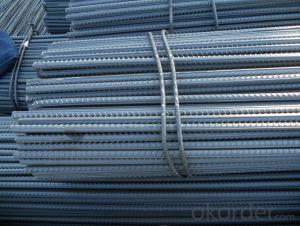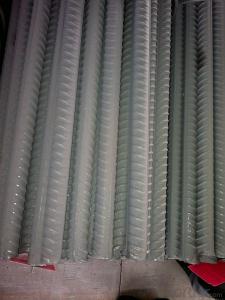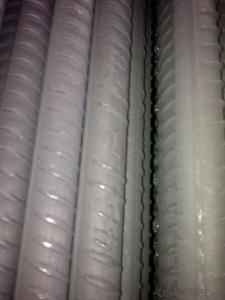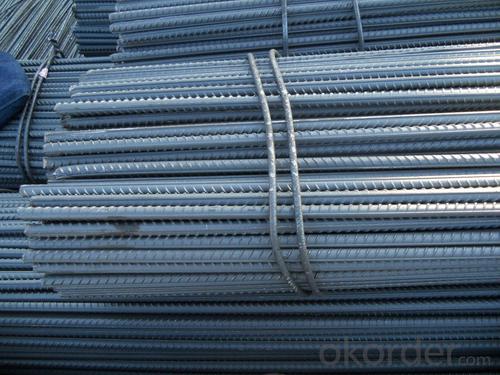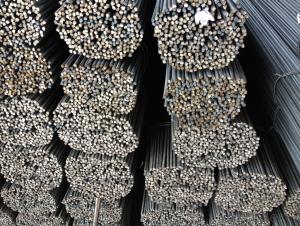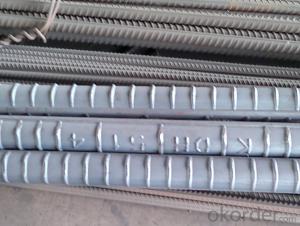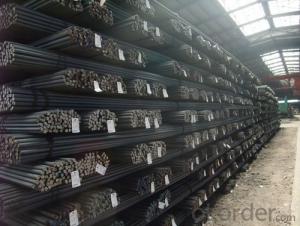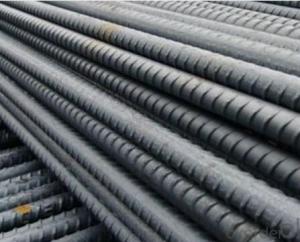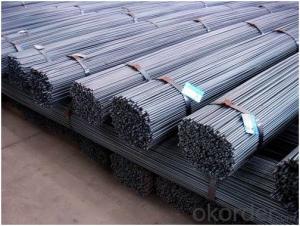Hot Rolled Deformed Steel Rebars for Buildings ASTM Standard
- Loading Port:
- Guangzhou
- Payment Terms:
- TT OR LC
- Min Order Qty:
- 25 m.t.
- Supply Capability:
- 200000 m.t./month
OKorder Service Pledge
OKorder Financial Service
You Might Also Like
Product Description:
OKorder is offering Hot Rolled Deformed Steel Rebars for Buildings ASTM Standard at great prices with worldwide shipping. Our supplier is a world-class manufacturer of steel, with our products utilized the world over. OKorder annually supplies products to European, North American and Asian markets. We provide quotations within 24 hours of receiving an inquiry and guarantee competitive prices.
Product Applications:
Hot Rolled Deformed Steel Rebars for Buildings ASTM Standard are ideal for structural applications and are widely used in the construction of buildings and bridges, and the manufacturing, petrochemical, and transportation industries.
1. Supporting members, most commonly in the house raising industry to strengthen timber bears under houses. Transmission line towers, etc
2. Prefabricated structure
3. Medium scale bridges
4. It is widely used in various building structures and engineering structures such as roof beams, bridges, transmission towers, hoisting machinery and transport machinery, ships, industrial furnaces, reaction tower, container frame and warehouse etc.
Product Advantages:
Hot Rolled Deformed Steel Rebars for Buildings ASTM Standard are durable, strong, and resist corrosion. And they are made of steel billets of high quality of China.
Main Product Features:
· Premium quality
· Prompt delivery & seaworthy packing (30 days after receiving deposit)
· Corrosion resistance
· Can be recycled and reused
· Mill test certification
· Professional Service
· Competitive pricing
Product Specifications:
Our supplier is a world-class manufacturer of steel, with our products utilized the world over. OKorder annually supplies products to European, North American and Asian markets. We provide quotations within 24 hours of receiving an inquiry and guarantee competitive prices.
Product Specifications:
Specifications of Hot Rolled Deformed Steel Rebars for Buildings ASTM Standard:
Standard | GB UK USA | HRB335 HRB400 HRB500 G460B, B500A, B500B,B500C GR40, GR60 | |
Diameter | 6mm,8mm,10mm,12mm,14mm,16mm,18mm,20mm, 22mm,25mm,28mm,32mm,36mm,40mm,50mm | ||
Length | 6M, 9M,12M or as required | ||
Packing | Export standard packing: wrapped by wire rod in bundles | ||
Each bundle weight | 2-3MT, or as required | ||
Trade terms | FOB, CFR, CIF | ||
Payment terms | TT payment in advance or Irrevocable LC at sight. | ||
Delivery Detail | within 45 days after received advanced payment or LC. | ||
Brand name | DRAGON | ||
Theoretical weight and section area of each diameter as below for your information:
Diameter(mm) | Section area (mm²) | Mass(kg/m) | Weight of 12m (kg) | Pcs/ton |
6 | 28.27 | 0.222 | 2.664 | 375.38 |
8 | 50.27 | 0.395 | 4.74 | 210.97 |
10 | 78.54 | 0.617 | 7.404 | 135.06 |
12 | 113.1 | 0.888 | 10.656 | 93.84 |
14 | 153.9 | 1.21 | 14.52 | 68.87 |
16 | 201.1 | 1.58 | 18.96 | 52.74 |
18 | 254.5 | 2.00 | 24 | 41.67 |
20 | 314.2 | 2.47 | 29.64 | 33.74 |
22 | 380.1 | 2.98 | 35.76 | 27.96 |
25 | 490.9 | 3.85 | 46.2 | 21.65 |
28 | 615.8 | 4.83 | 57.96 | 17.25 |
32 | 804.2 | 6.31 | 75.72 | 13.21 |
36 | 1018 | 7.99 | 98.88 | 10.43 |
40 | 1257 | 9.87 | 118.44 | 8.44 |
50 | 1964 | 15.42 | 185.04 | 5.40 |
Chemical Composition: (Please kindly find our chemistry of our material based on JIS as below for your information)
JISG3112 SD390 | Chemical Composition | ||||
C | Mn | Si | S | P | |
0.22 | 1.38 | 0.4 | 0.014 | 0.022 | |
Physical capability | |||||
Yield Strength(N/cm²) | Tensile Strength(N/cm²) | Elongation (%) | |||
620 | ≥400 | 21 | |||
The production process of Steel Rebar

1-Waling beam furnace 2-Roughing rolling group 3-Intermediate rolling train
4-Finishing rolling group 5-Water-cooling device 6-Walking beam cooler
7-Finishing equipment(including the cold scale shear,short feet collection system,
automatic counting device,bundling machine, collect bench)
Usage and Applications of Hot Rolled Deformed Steel Rebars for Buildings ASTM Standard:
Hot Rolled Deformed Steel Rebars for Buildings GB Standard is widely used in buildings, bridges, roads and other engineering construction. Big to highways, railways, bridges, culverts, tunnels, public facilities such as flood control, dam, small to housing construction, beam, column, wall and the foundation of the plate, deformed bar is an integral structure material. With the development of world economy and the vigorous development of infrastructure construction, real estate, the demand for deformed bar will be larger and larger..
Packaging & Delivery of Hot Rolled Deformed Steel Rebars for Buildings ASTM Standard:
Packaging Detail: products are packed in bundle and then shipped by container or bulk vessel, deformed bar is usually naked strapping delivery, when storing, please pay attention to moisture proof. The performance of rust will produce adverse effect.
Price: Keep lower operating costs so as to offer competitive price for our clients
Deformed Steel Rebars according to Korean standard
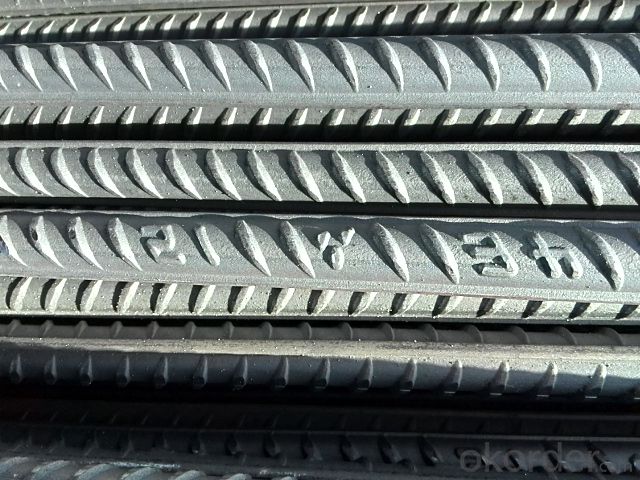
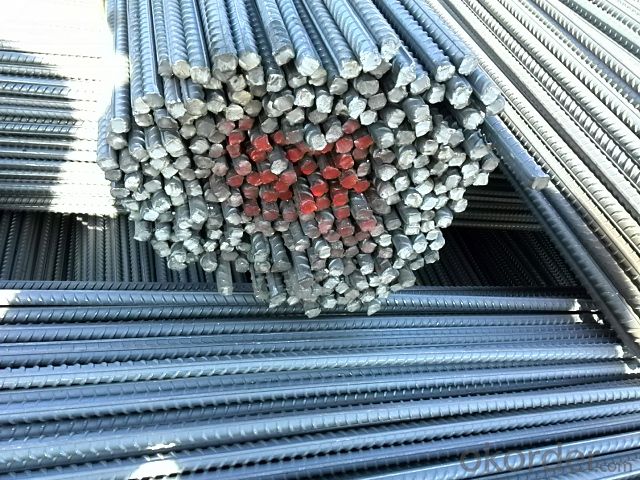
FAQ:
Q1: How do we guarantee the quality of our products?
A2: We have established an advanced quality management system which conducts strict quality tests at every step, from raw materials to the final product. At the same time, we provide extensive follow-up service assurances as required.
Q2: Why buy Deformed Steel Rebars for Buildings ASTM Standard from OKorder.com?
A1: All products offered byOKorder.com are carefully selected from China's most reliable manufacturing enterprises. Through its ISO certifications, OKorder.com adheres to the highest standards and a commitment to supply chain safety and customer satisfaction.
Q3: How soon can we receive the product after purchase?
A3: Within three days of placing an order, we will begin production. The specific shipping date is dependent upon international and government factors, but is typically 7 to 10 workdays.
- Q: How do steel rebars improve the ductility of concrete?
- Steel rebars improve the ductility of concrete by acting as reinforcement within the material. The presence of rebars helps to distribute stress and load more evenly throughout the concrete structure, making it more resistant to cracks and fractures. This reinforcement also allows the concrete to withstand bending and stretching forces, enhancing its overall flexibility and ability to deform without failing.
- Q: What is the impact of steel rebars on the carbon footprint of a building?
- The carbon footprint of a building is greatly influenced by steel rebars, which are manufactured through a process that involves extracting raw materials like iron ore and then smelting and refining them into steel. This production phase alone results in greenhouse gas emissions and consumes a significant amount of energy. Furthermore, the transportation and construction of steel rebars also contribute to the building's carbon footprint. Fossil fuels are used for transportation, releasing carbon dioxide into the atmosphere. Moreover, the construction phase relies on heavy machinery and equipment that further adds to carbon emissions because of their dependence on fossil fuels. The carbon footprint of steel rebars extends beyond the construction phase as well. While steel is highly durable and can last for many years, it requires maintenance and may need to be replaced over time. These activities, such as repairs or demolitions, result in additional carbon emissions due to transportation, energy consumption, and waste management. However, it is important to acknowledge that steel rebars can offer environmental benefits when used in high-performance buildings or sustainable construction practices. For example, steel is recyclable, and reusing steel rebars can significantly reduce the carbon footprint associated with their production. Additionally, steel rebars provide structural strength, enabling the construction of taller and more efficient buildings that can potentially reduce long-term energy consumption. To minimize the carbon footprint of a building, it is crucial to consider alternative materials like recycled steel or other low-carbon materials during the construction process. Additionally, implementing energy-efficient practices throughout the building's lifecycle, including reducing energy consumption and improving waste management, can further mitigate the environmental impact of steel rebars.
- Q: What is the difference between three - grade steel and two - grade steel?
- Three grade thread steel HRB400, two grade thread steel HRB335, now the thread steel is inside the building must be less, then three grade screw steel and two grade thread steel is mainly used for what aspect, in order to solve this problem.
- Q: What is the impact resistance of steel rebars?
- The impact resistance of steel rebars is generally high due to the material's ability to absorb and distribute forces upon impact, making it a reliable choice for reinforcing structures and withstanding sudden loads or accidental impacts.
- Q: How do steel rebars affect the overall noise insulation of a structure?
- Steel rebars have a minimal impact on the overall noise insulation of a structure. This is because noise insulation primarily depends on the density and thickness of the materials used in the construction of walls, floors, and ceilings. Steel rebars, being used to reinforce concrete structures, do not significantly contribute to the sound insulation properties of a building. The primary function of steel rebars is to provide strength and stability to the concrete, ensuring its structural integrity. They are typically embedded within the concrete, resulting in their presence throughout the building's framework. However, the steel rebars themselves do not possess any sound-absorbing or sound-blocking characteristics. To enhance the noise insulation of a structure, other sound insulation materials such as insulation boards, acoustic panels, or soundproofing materials need to be incorporated into the building design. These materials are specifically designed to absorb or block sound waves, reducing the transmission of noise from one area to another. While steel rebars may not directly contribute to noise insulation, they indirectly play a role in maintaining the overall structural integrity of a building. A well-constructed and sturdy structure can help minimize vibrations and sound transmission caused by external noise sources. Therefore, while steel rebars themselves do not significantly affect noise insulation, their presence indirectly contributes to a more solid and stable building, which can help reduce structural vibrations and unwanted noise.
- Q: What are the common surface patterns for steel rebars?
- The common surface patterns for steel rebars include plain, deformed, and ribbed patterns. Plain rebars have a smooth surface without any patterns or indentations. They are commonly used in applications where the rebar needs to be easily bendable or welded, such as in reinforced concrete structures. Deformed rebars, on the other hand, have patterns or indentations on their surface. These patterns are typically in the form of ribs, humps, or indentations that provide enhanced bonding characteristics with the surrounding concrete. The deformations improve the grip between the rebar and concrete, ensuring better transfer of stresses and preventing slippage. Deformed rebars are widely used in construction projects, especially in areas where high tensile strength and bond strength are required. Ribbed rebars are a specific type of deformed rebar that have continuous longitudinal ribs along their length. These ribs are usually evenly spaced and provide additional anchorage and bond strength with the concrete. Ribbed rebars are commonly used in applications where a higher level of bond strength is required, such as in seismic zones or in structures subjected to heavy loads. Overall, the choice of surface pattern for steel rebars depends on the specific requirements of the construction project and the desired performance characteristics.
- Q: What is the role of steel rebars in minimizing the risk of concrete spalling due to sulfate attack?
- Steel rebars play a crucial role in minimizing the risk of concrete spalling due to sulfate attack by providing reinforcement and increasing the overall strength of the concrete structure. When concrete is exposed to sulfate ions, it can undergo a chemical reaction that leads to expansion and cracking, resulting in spalling. However, steel rebars act as a reinforcement, helping to distribute the stress and load throughout the concrete, reducing the risk of cracking and spalling. Additionally, the presence of rebars helps to maintain the structural integrity of the concrete, preventing the ingress of sulfate ions and minimizing the potential for sulfate attack.
- Q: Can steel rebars be used in corrosive chemical environments?
- Steel rebars can be used in corrosive chemical environments, but their performance and durability may be compromised. Steel is susceptible to corrosion when exposed to certain chemicals, especially those that are acidic or contain chlorides. In such corrosive environments, the rebars can undergo corrosion, leading to structural damage and reduced load-bearing capacity. To mitigate the corrosion risk, various measures can be taken. One common approach is to coat the rebars with a protective layer, such as epoxy or zinc coating, to create a barrier between the steel and the corrosive environment. Additionally, using stainless steel rebars or other corrosion-resistant alloys can provide better resistance against chemical corrosion. It is crucial to consider the specific chemicals present in the environment and consult with corrosion engineers and experts to determine the appropriate measures for using steel rebars in corrosive chemical environments. Proper maintenance and regular inspections are also necessary to monitor any signs of corrosion and take prompt corrective action to ensure the structural integrity and safety of the reinforced concrete structures.
- Q: Are steel rebars suitable for use in structures with high resistance to corrosion?
- No, steel rebars are not suitable for use in structures with high resistance to corrosion.
- Q: How do steel rebars prevent the concrete from cracking under tension?
- Steel rebars reinforce concrete and increase its structural integrity, preventing cracking under tension. Concrete has low tensile strength and tends to crack when subjected to tensile forces. However, when steel rebars are embedded in the concrete, they absorb and distribute these forces, acting as reinforcement. Typically made of high-strength steel, the rebars have a much higher tensile strength compared to concrete. As a result, when the concrete is under tension, the rebars bear most of the load, preventing cracking. The rebars act as a framework or skeleton within the concrete, resisting the tensile forces and ensuring its structural stability. Furthermore, the bond between the steel rebar and the concrete also plays a role in preventing cracking under tension. The ribbed or deformed surface of the rebars enhances the bond with the surrounding concrete, creating a strong connection. This bond allows the rebars to transfer the tensile forces to the concrete matrix more effectively, reducing the risk of cracking. By reinforcing the concrete, steel rebars help distribute the tensile forces evenly throughout the structure. This prevents localized stress concentrations and minimizes the chances of cracks forming. Additionally, if cracks do occur, the presence of rebars can help control their propagation by acting as barriers that restrict further spread. In conclusion, steel rebars provide reinforcement, increase the strength of concrete, and prevent cracking under tension. They bear the tensile forces, distribute them evenly, and enhance the bond between the rebar and the concrete. This reinforcement ensures the structural integrity of the concrete and helps prevent cracking.
Send your message to us
Hot Rolled Deformed Steel Rebars for Buildings ASTM Standard
- Loading Port:
- Guangzhou
- Payment Terms:
- TT OR LC
- Min Order Qty:
- 25 m.t.
- Supply Capability:
- 200000 m.t./month
OKorder Service Pledge
OKorder Financial Service
Similar products
Hot products
Hot Searches
Related keywords
